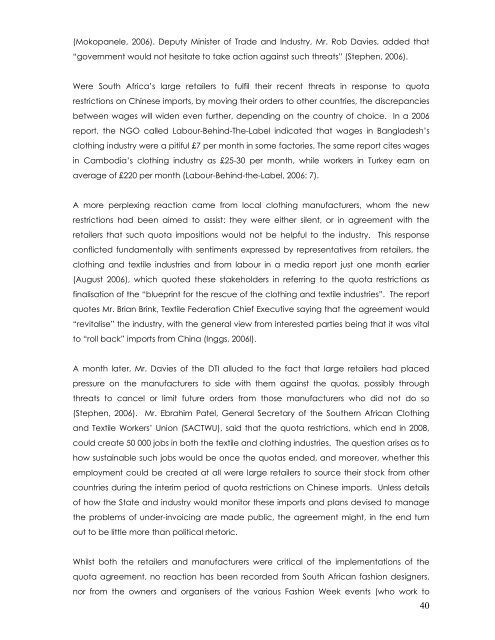Create successful ePaper yourself
Turn your PDF publications into a flip-book with our unique Google optimized e-Paper software.
(Mokopanele, 2006). Deputy Minister of Trade and Industry, Mr. Rob Davies, added that<br />
“government would not hesitate to take action against such threats” (Stephen, 2006).<br />
Were South Africa’s large retailers to fulfil their recent threats in response to quota<br />
restrictions on Chinese imports, by moving their orders to other countries, the discrepancies<br />
between wages will widen even further, depending on the country of choice. In a 2006<br />
<strong>report</strong>, the NGO called Labour-Behind-The-Label indicated that wages in Bangladesh’s<br />
clothing industry were a pitiful £7 per month in some factories. The same <strong>report</strong> cites wages<br />
in Cambodia’s clothing industry as £25-30 per month, while workers in Turkey earn on<br />
average of £220 per month (Labour-Behind-the-Label, 2006: 7).<br />
A more perplexing reaction came from local clothing manufacturers, whom the new<br />
restrictions had been aimed to assist: they were either silent, or in agreement with the<br />
retailers that such quota impositions would not be helpful to the industry. This response<br />
conflicted fundamentally with sentiments expressed by representatives from retailers, the<br />
clothing and textile industries and from labour in a media <strong>report</strong> just one month earlier<br />
(August 2006), which quoted these stakeholders in referring to the quota restrictions as<br />
finalisation of the “blueprint for the rescue of the clothing and textile industries”. The <strong>report</strong><br />
quotes Mr. Brian Brink, Textile Federation Chief Executive saying that the agreement would<br />
“revitalise” the industry, with the general view from interested parties being that it was vital<br />
to “roll back” imports from China (Inggs, 2006l).<br />
A month later, Mr. Davies of the DTI alluded to the fact that large retailers had placed<br />
pressure on the manufacturers to side with them against the quotas, possibly through<br />
threats to cancel or limit future orders from those manufacturers who did not do so<br />
(Stephen, 2006). Mr. Ebrahim Patel, General Secretary of the Southern African Clothing<br />
and Textile Workers’ Union (SACTWU), said that the quota restrictions, which end in 2008,<br />
could create 50 000 jobs in both the textile and clothing industries. The question arises as to<br />
how sustainable such jobs would be once the quotas ended, and moreover, whether this<br />
employment could be created at all were large retailers to source their stock from other<br />
countries during the interim period of quota restrictions on Chinese imports. Unless details<br />
of how the State and industry would monitor these imports and plans devised to manage<br />
the problems of under-invoicing are made public, the agreement might, in the end turn<br />
out to be little more than political rhetoric.<br />
Whilst both the retailers and manufacturers were critical of the implementations of the<br />
quota agreement, no reaction has been recorded from South African fashion designers,<br />
nor from the owners and organisers of the various Fashion Week events (who work to<br />
40
















